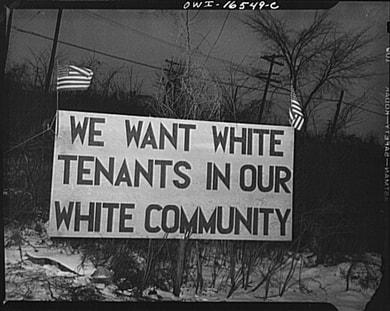 Sign posted near the planned site of the Sojouner Truth Housing Project for black workers moving to Detriot to work in automotive factors to support the war effort.
Sign posted near the planned site of the Sojouner Truth Housing Project for black workers moving to Detriot to work in automotive factors to support the war effort. The Detroit riots were one of five that summer; it followed ones in Beaumont, TX, Harlem, NY, Los Angeles, CA (the Zoot Suit Riot), and Mobile, AL.
The rioting in Detroit began among youths at Belle Isle Park on June 20, 1943; the unrest moved into the city proper and was exacerbated by false rumors of racial attacks in both the black and white communities. It continued until June 22. It was suppressed after 6,000 federal troops were ordered into the city to restore peace. A total of 34 people were killed, 25 of them black and most at the hands of the white police force, while 433 were wounded (75 percent of them black), and property valued at $2 million ($30.4 million in 2020 US dollars) was destroyed. Most of the riot took place in the black area of Paradise Valley, the poorest neighborhood of the city.
At the time, white commissions attributed the cause of the riot to black people and youths. But the NAACP claimed deeper causes: a shortage of affordable housing, discrimination in employment, lack of minority representation in the police, and white police brutality. A late 20th-century analysis of the rioters showed that the white rioters were younger and often unemployed (characteristics that the riot commissions had falsely attributed to blacks, despite evidence in front of them). If working, the whites often held semi-skilled or skilled positions. Whites traveled long distances across the city to join the first stage of the riot near the bridge to Belle Isle Park, and later some traveled in armed groups explicitly to attack the black neighborhood in Paradise Valley. The black participants were often older, established city residents, who in many cases had lived in the city for more than a decade. Many were married working men and were defending their homes and neighborhood against police and white rioters. They also looted and destroyed white-owned property in their neighborhood.
 RSS Feed
RSS Feed